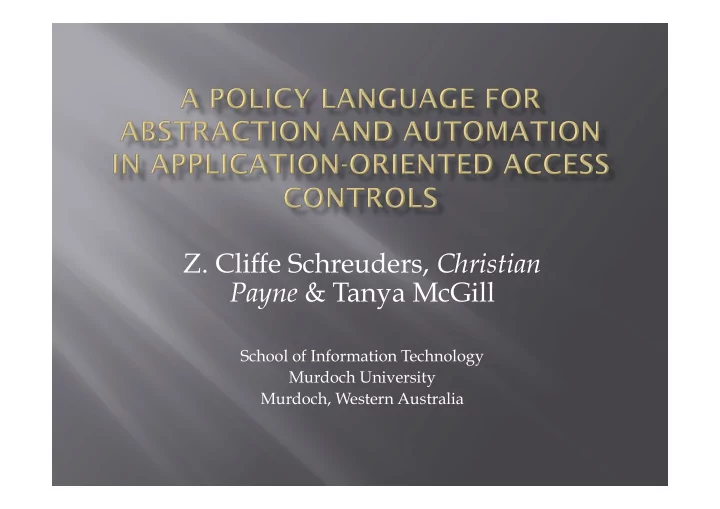

Z. Cliffe Schreuders, Christian Payne & Tanya McGill School of Information Technology Murdoch University Murdoch, Western Australia
¨ Programs behaving maliciously are a major security problem. ¡ Simple solutions are clumsy and inefficient. ¡ Complex solutions are, well... complex! ¨ The Functionality-Based Access Control model aims to make these complex solutions more manageable and user-friendly. ¨ This paper describes how design decisions in the policy language underpin these usability improvements.
¨ Traditionally security models centre around what users can do. ¨ Different security models were developed according to requirements, with appropriate policy schemes to support these. ¡ DAC ¡ MAC ¡ RBAC ¨ In general, these models focused on separating differently privileged users from one another.
¨ Assumed: the software always acts on behalf of the user. ¨ Overwhelmingly these security models give each program all of the user’s privileges. ¨ The user has little choice: they run the program with full privileges or not at all.
¨ Vulnerabilities ¡ Software contains bugs or design problems that allow it to be attacked and subverted. ¨ Malware ¡ Software is malicious by design. ¡ Distribution of software via the Internet exposes users almost continually. ¨ Virus scanning and patching vulnerabilities is reactive: doesn’t address the underlying problem of excessive privilege.
¨ One solution is to isolate applications from one another to limit the potential damage. ¡ E.g., sandboxing ¨ Problems: ¡ Excessive redundancy: duplicated resources. ¡ Interchange of data is problematic: ú Involves bypassing the isolation. ú Inconvenient; interferes with natural workflow.
¨ Restrict each application individually based on a set of rules specific to that program. ¡ Avoids problems with simple isolation-based approaches. ¨ Early rule-based mechanisms include: ¡ TRON, Systrace, DTE. ¨ Current Linux mechanisms: ¡ SELinux, AppArmor.
¨ However, generating custom rules specifying low-level privileges for individual applications is not easy: ¡ Low-level privileges are difficult to understand. ¡ Many different programs run on a single system. ¡ Rule specifics vary from system to system. ¨ Avoided in practice using learning modes: ¡ Program is run and resource requirements are monitored and recorded. ¡ This establishes a policy that then confines the program in the future.
¨ Requires program behaviour during analysis to cover all privileges required. ¨ In practice, program is unconfined when generating policy. ¡ If malicious, system may be already compromised! ¨ User must verify a policy correctness: ¡ Requires expertise and patience. ¡ “Just click OK”. ¨ Better if policy can be generated a priori .
¨ FBAC restricts programs based upon the functionality they are expected to provide. ¡ Far more usable than existing approaches. ¨ Important features: ¡ Built around policy abstractions: functionalities . ¡ Functionalities are hierarchical: provide multiple layers of abstraction. ¡ Parameterisation: adaptable to specific circumstances. ¨ Policies expressed in FBAC-PL.
¨ Name-based resource descriptors. ¨ Three types of policy files: ¡ Confinements : defines where policies are stored and who can manage them. ¡ Functionalities : building blocks for application policies. ¡ Application policies : security policy for individual programs. ¨ FBAC-PL syntax is described in the paper.
¨ The design of FBAC and FBAC-PL both aid usability. ¨ Users are not required to actually use/interact with the policy language directly: ¡ Policy is constructed using a GUI policy manager.
¨ The policy manager analyses the selected application and can suggest functionalities on which to build the policy. ¡ Uses specified dependencies and metadata. FBAC-PL supports these ¨ automated suggestions by the various directives embedded in the functionality definitions.
Users adapt generalised functionalities to their specific requirements by supplying parameters.
functionality Irc_Chat_Client { functionality_description "An irc (chat) client."; highlevel; category network_client; suggest_functionality iconcategory "IRCClient"; suggest_functionality uses_library "python-irclib"; parameter chat_IRC_servers "*"; parameter_description "the remote servers the program can connect to to chat with IRC and send files with DCC"; parameter_type IP; parameter_automate usedefault; parameter IRC_remote_port {"6665-6669":"7000":"194":"9- 94"}; parameter_description "the local chat (IRC) port. Usually 6667 or nearby (6665-6669) or rarely 194 or 994 (secure)"; parameter_type port; parameter_automate usedefault; ... ...
application konversation { executablepaths /opt/kde3/bin/konversation; functionality Standard_Graphical_Application (peruser_directory="/home/*/.kde/share/apps/konver- sation/", peruser_files="/home/*/.kde/share/config/konversat- ionrc", application_libraries_directory="", libraries_fileextension=<default>, config_directory="/home/*/.kde/share/apps/konversa- tion/", config_files="", read_only_directory="/opt/kde3/shar/apps/konversat- ion/"); functionality Irc_Chat_Client (chat_IRC_servers=<default>, IRC_remote_port=<default>, save_received_files_in_directory="/home/cliffe/dow- nloads/", send_files_in_directory=""); functionality Uses_Perl (); }
¨ Existing user-oriented access controls suffer from various problems. ¨ FBAC model avoids usability weaknesses associated with rule-based approaches. ¨ Security policy is defined in a hierarchical way, aiding abstraction. ¨ Functionality policy building blocks aid automation to assist the user. ¨ Users can easily adapt generated policies using parameterisation. ¨ Allows end users to easily control what their applications do.
Recommend
More recommend